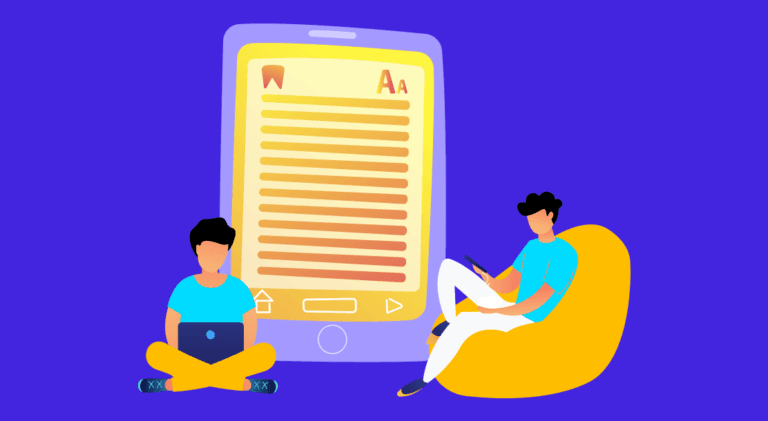
Although writing an ebook is a time-consuming task, it is an essential tool for inbound marketing professionals. It is also a terrific approach to finding prospective leads for your company. Ebooks are a brilliant way to establish domain authority, and brand yourself as an expert.
The letter “e” in the ebook stands for “electronic.” And, when implemented right, that “e” may also stand for “efficient,” “entertaining,” and even “exhilarating.” But more often than not, first-time ebook writers get caught up in the subject and make certain errors that can be quite catastrophic, if not kept in check. This blog talks about the most common ebook mistakes to avoid.
10 Ebook Mistakes That Are Best Avoided
Here, we list ten common mistakes people make when building an ebook, and ways to avoid them.
1. Lackluster cover

It’s likely you’ve heard that forming opinions about anything only takes a fraction of a second. This is true of ebooks as well. Your target purchaser’s desire to read your book will be greatly reduced if the cover art is dull and uninspiring. Keep in mind that your cover art will most likely be viewed as a tiny picture on a web page, so keep it simple, attractive, and clutter-free. Also, make absolutely sure the title catches the reader’s eye and addresses the problems you’re attempting to solve.
2. Repetition in content
Remember that certain customers will simply go through a section of your material, while others may go over everything you’ve written. If consumers see that most of your publications have the same design or content, they’ll find it extremely difficult to distinguish between them, and will most likely leave the page.
While you should follow your brand style guide and editorial guidelines to a T, you still have a bit of creative freedom. Every piece of content you put out has to be unique in some way. Experimenting with logo placement, writing styles, and imagery will help you avoid this ebook mistake.
3. Lack of visuals
Ebooks must include facts and figures that corroborate the points being made and establish the most compelling arguments. Instead of simply listing data, use charts, comparison diagrams, scatter plots, as well as other visuals, to convey your point clearly. Visuals have been known to boost comprehension by up to 400%.
4. Incompatibility across platforms

Another consideration in design is the ease with which the text can be reproduced and viewed. It’s likely that the individual who downloads your ebook isn’t the only one who’ll consume its content. They may want to generate extra copies for evaluation by other members of their team. So, make sure your ebook is compatible with all devices, including mobile phones.
5. Endless text
Nothing throws people off faster than a page that is entirely made up of text. Readers like things reduced into smaller, more consumable portions and, when possible, brief concepts. Don’t put yourself in the position of having readers mark your content “TL:DR” (too long, didn’t read). Instead, use white space, graphics, and bullet points to offer readers visual relief as well as the ability to grasp information efficiently. This advice especially applies to web content writing.
6. Weak structure
Don’t make your ebook read like a textbook. Use subheads to direct the reader and look for subtle themes inside each chapter to draw on. It will appear to be more well-organized and easy to follow. Remember the rule regarding visuals and use a relevant visual to complement the ideas being communicated.
7. Complicated language

Not every person reading your book may be an expert on the topic at hand. Many people also read to learn. Ensure that you communicate things in a way that imparts knowledge across all levels of expertise, easily. If you’re not explaining a concept in your ebook, provide resources for people to understand it better.
8. Textual monotony
It’s not necessary that once someone downloads your ebook, they’ll examine it. A user will frequently skim through an ebook to see whether it is of interest to them. To avoid your ebook being placed into the virtual bag of discarded activities, it’s critical to inspire a desire to read and consume the content immediately.
Create a feeling of urgency and curiosity by using “snackable” elements to emphasize certain fascinating, can’t-miss parts. They can be anything from giveaways and quizzes to surveys and polls. This way, you’ll pique people’s interest in learning more.

9. Lack of value for the reader
Displaying and demonstrating a piece of technology or a new-age process may be fascinating, but explaining to your readers how and why it will save a company millions of dollars boosts productivity, enhances employee satisfaction, optimizes workflows, improves information security, as well as many other advantages. Make the information helpful, and back it up with proof. Substantiate, add value, and tell your prospect how they, by implementing the advice in your book, would become successful.
10. Overselling yourself
Never be biased towards yourself. Present a fair evaluation of all market players.
When a buyer is looking into high-value purchases that may consume a significant portion of their budget, they almost surely evaluate various options before reaching a decision.
Your prospective buyer will be curious to see how your product compares to the rest of the competition. Make it simple for them by telling them how your product stands out and how it will solve their pain points. Don’t make it sound overly salesy, as doing so will make the reader lose interest.
Ebooks are a vital tool for attracting and nurturing both prospective and current clients, and they are the foundation of every successful inbound promotional campaign. After publishing your ebook, you undoubtedly feel like you need a well-deserved vacation, but don’t be gone for too long!
Keep in touch with your readers and don’t make them wait forever for your next publication, whether it is a part of a series or a standalone piece. Evaluate whether you would supplement your ebooks with other value-added services. Can you, for instance, provide a seminar or a computer-based training session on a topic you wrote the ebook on? We’ll leave it here for you to ponder upon.
FAQs
An ebook is an electronic version of a physical book. They are especially helpful in digital marketing, as they help establish you as an expert, provide users with meaningful information, and help in lead generation.
Some ebook mistakes include not using enough visuals, weak structuring, poor cover design, using complicated language, and sounding overly salesy.
Here are a few tips for writing an ebook:
– Choose a topic depending on your audience’s needs.
– Write in plain English; avoid jargon and complicated language.
– Fact-check information.
– Use ample statistics and quotes.
– Edit your work.
Latest Blogs
Explore how Google’s 2025 AI search updates triggered ranking chaos. Learn actionable strategies to adapt your SEO for AI Overviews, zero-click searches, and SERP volatility. Stay ahead now.
Learn how to rank on AI search engines like ChatGPT, Perplexity, and Gemini by optimizing your content for authority, structure, and relevance. Stay ahead in AI-driven search with this strategic guide.
Explore the best healthcare SEO services for your medical practice. Improve online visibility and effectively reach more patients in need of your services.
Get your hands on the latest news!
Similar Posts

Books and Ebooks
5 mins read
7 Tips on How to Write an e-Book Successfully in 2022

Books and Ebooks
6 mins read
A Complete Guide to the Perfect Professional Ebook Cover Design

Books and Ebooks
6 mins read